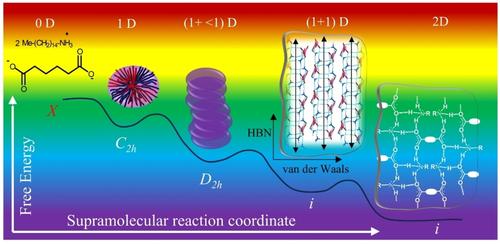当前位置:
X-MOL 学术
›
Chem. Asian J.
›
论文详情
Our official English website, www.x-mol.net, welcomes your
feedback! (Note: you will need to create a separate account there.)
Symmetry Breaking in Supramolecular Gel Condensation
Chemistry - An Asian Journal ( IF 3.5 ) Pub Date : 2024-12-10 , DOI: 10.1002/asia.202401249
Pathik Sahoo 1
Chemistry - An Asian Journal ( IF 3.5 ) Pub Date : 2024-12-10 , DOI: 10.1002/asia.202401249
Pathik Sahoo 1
Affiliation

|
Supramolecular condensation during cooling cycles often transitions through multiple metastable phases before achieving a stable crystalline state. Metastability arises from various competing parameters like symmetrical arrangement, and supramolecular bonding and manifests at different temperatures. Symmetrical physical arrangements can minimize vibrational energy and stabilize the systems at higher temperatures. Further cooling promotes directional supramolecular bonding, such as charge-assisted hydrogen bonding, resulting in molecular periodicity within metastable structures. Frustration occurs when weaker van der Waals bonds form during further cooling, propagating perpendicularly to stronger one-dimensional charge-assisted hydrogen bonds and disrupting lateral periodicity in certain solvents. This makes parallel 1D fibers slidable, adding flexibility to the gel fiber. Eventually, some supramolecular systems attain thermodynamically stable crystalline states by perfectly arranging all the molecules. Throughout the process, metastability results from different symmetrical arrangements, and each rearrangement alters the supramolecular structure‘s symmetry, generating new physicochemical properties. Different supramolecular gels uniquely break symmetry, which can be monitored through various techniques. This perspective analyzes supramolecular thermoreversible, reverse thermal, liquid crystalline, thixotropic, and antisolvent-induced gels to illustrate spontaneous symmetry reduction processes. Reaching a suprasymmetry condensate can classify big data and be applied in unconventional analogue computing or data storage.
中文翻译:

超分子凝胶缩合中的对称性破坏
冷却循环期间的超分子缩合通常会经过多个亚稳相,然后才能达到稳定的结晶状态。亚稳态由对称排列和超分子键等各种竞争参数产生,并在不同的温度下表现出来。对称的物理布置可以最大限度地减少振动能量并在较高温度下稳定系统。进一步冷却促进定向超分子键合,例如电荷辅助氢键,从而导致亚稳结构内的分子周期性。当在进一步冷却过程中形成较弱的范德华键时,就会出现挫折,垂直于更强的一维电荷辅助氢键传播,并破坏某些溶剂中的横向周期性。这使得平行的 1D 纤维可滑动,从而增加了凝胶纤维的柔韧性。最终,一些超分子系统通过完美地排列所有分子而获得热力学稳定的结晶状态。在整个过程中,亚稳态是由不同的对称排列产生的,每次重排都会改变超分子结构的对称性,产生新的物理化学性质。不同的超分子凝胶独特地打破了对称性,这可以通过各种技术进行监测。该视角分析了超分子热可逆、反向热、液晶、触变性和反溶剂诱导的凝胶,以说明自发对称性还原过程。达到超对称凝聚态可以对大数据进行分类,并应用于非常规模拟计算或数据存储。
更新日期:2024-12-10
中文翻译:

超分子凝胶缩合中的对称性破坏
冷却循环期间的超分子缩合通常会经过多个亚稳相,然后才能达到稳定的结晶状态。亚稳态由对称排列和超分子键等各种竞争参数产生,并在不同的温度下表现出来。对称的物理布置可以最大限度地减少振动能量并在较高温度下稳定系统。进一步冷却促进定向超分子键合,例如电荷辅助氢键,从而导致亚稳结构内的分子周期性。当在进一步冷却过程中形成较弱的范德华键时,就会出现挫折,垂直于更强的一维电荷辅助氢键传播,并破坏某些溶剂中的横向周期性。这使得平行的 1D 纤维可滑动,从而增加了凝胶纤维的柔韧性。最终,一些超分子系统通过完美地排列所有分子而获得热力学稳定的结晶状态。在整个过程中,亚稳态是由不同的对称排列产生的,每次重排都会改变超分子结构的对称性,产生新的物理化学性质。不同的超分子凝胶独特地打破了对称性,这可以通过各种技术进行监测。该视角分析了超分子热可逆、反向热、液晶、触变性和反溶剂诱导的凝胶,以说明自发对称性还原过程。达到超对称凝聚态可以对大数据进行分类,并应用于非常规模拟计算或数据存储。

































 京公网安备 11010802027423号
京公网安备 11010802027423号